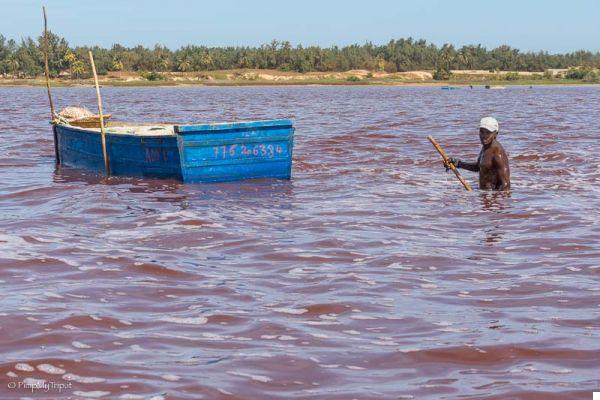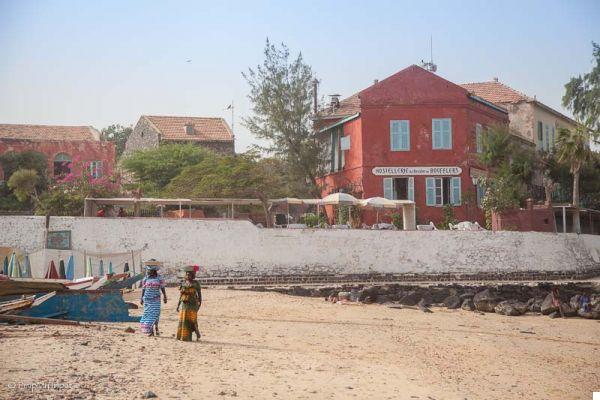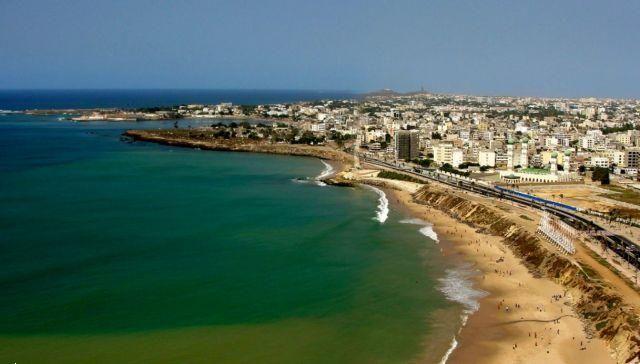Un trip to Senegal it is undoubtedly the easiest way to get to know West Africa.
Senegal is in fact a stable country that allows travelers to travel do-it-yourself in a serene way: the climatic conditions are not extreme, the people are welcoming (they call Senegal the "country of teranga”, or rather of hospitality)
and for this reason it is known as a part of “soft” Africa.
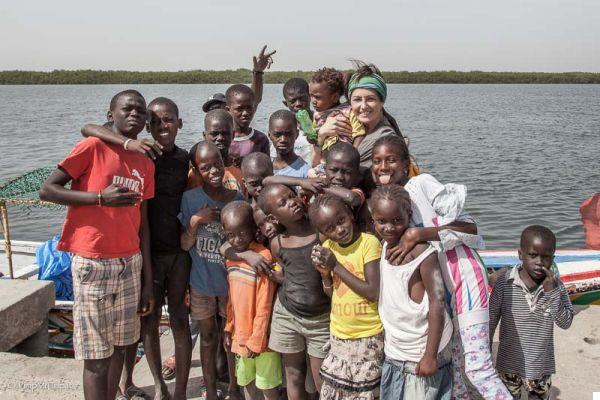
Senegal is the country of “teranga”, that is, of hospitality
it is true that Senegal does not have parks like it Tanzania and cannot boast such exceptional views as the Namibia, but it is precisely because of its characteristics that it is defined a country "to live" rather than "to see".
With these tips I try to help you organize yours trip to Senegal do it yourself if not perfect, at least come close.
- 1 - Before leaving
- 1.1 Information at a glance
- 1.2 Is it safe to travel to Senegal?
- 2 - What to pack
- 3 - How much does it cost to travel to Senegal?
- 3.1 Hotel, guesthouse and camp
- 3.2 Restaurants
- 3.3 Transportation
- 4 - What to see: Places not to be missed
- 4.1 Dakar, the capital
- 4.2 Gorée Island
- 4.3 The village of Toubab Dialaw
- 4.4 Yoff and the Isle of N'Gor
- 4.5 Saint Louis
- 4.6 Delta del Sine Saloum
- 4.7 Casamance
- 4.7 Joal-Fadiouth, the Island of the Shells
- 4.7 Pink Lake
- 4.8 Lompoul Desert
- 5 - Experiences not to be missed
- 5.1 Visit the Mbour fish market
- 5.2 Visit a fishing village
- 5.3 Take a pirogue ride through the mangroves
- 5.4 Take a collective taxi
- 6 things to taste absolutely
- 6.1 Thiéboudienne
- 6.2 Yassa Chicken
- 6.3 Shrimp avocad
- 6.4 Touba coffee
- 6.5 Bissap, bissap, bissap!
- 6.6 Ditakh
- 6.7 What if you are a vegetarian?
- 7 - Getting around by public transport
- 8 - Sexual Tourism in Senegal
Before leaving
To travel to Senegal you do not need an entry visa for those with passport.
Some vaccinations are recommended and, if you travel in the rainy season, also consider doing it antimalarial prophylaxis.
Essential Information
- Language: French and Wolof.
- Religion: most of the population is Muslim even if compared to other countries such as Iran, the mentality is very open and not everyone follows the "rules" that religion imposes.
- Currency: the official currency is the free sefa (1 € = circa 656 CFA).
- When to go: best time to travel to Senegal is undoubtedly what goes from December to May, when the heat is not oppressive and the climate is dry. Normally the rainy season is at its peak from July through September when temperatures are much higher and water bombs make travel more difficult.
is it safe to travel to Senegal?
Unfortunately, Senegal, like many of the West African countries, has the reputation of being a poor and consequently unsafe country.
In my experience, however, I have never experienced any feelings of fear.
Obviously bad luck happens, but it can happen anywhere, in any country and at any time.
Common sense as always (and your instincts) is the watchword. Beware of thieves in the markets and beware of your bags or valuables like your phone or camera.
Never carry too much money with you (and above all do not show your bribes around) and try not to walk alone and at night in the outskirts of Dakar.
I major dangers in Senegal in my opinion they are dirt and the risk of infections. Use closed shoes as much as possible and be careful when walking on the beach barefoot (try not to open your foot with a glass bottle like I did).
I means of transport they can be dangerous, but in my experience in Senegal the drivers drive much better than in other countries of the world.
Before leaving anyway consult the website of Safe Travel on Senegal.
What to pack
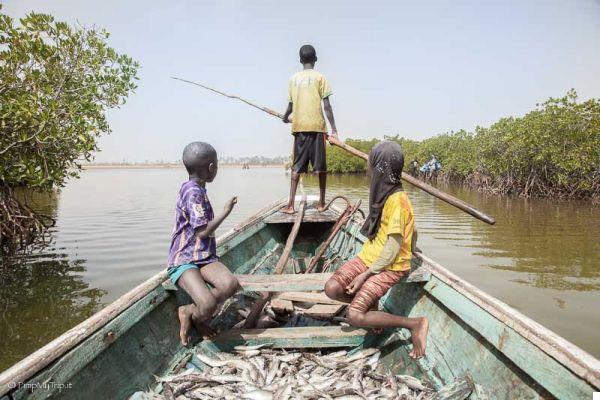
Experiences to live in Senegal: visit the fishing villages on pirogues full of fish!
Personal health and safety
the vaccination for yellow fever and it is advisable to take the vaccination certificate with you (probably no one will ever ask you, but in case it is better to have it).
The Hepatitis A and B vaccinations, l'antitetanica andantitific. In the wet season it would also be better to do anti-malarial prophylaxis.
In any case, always ask your doctor first or at the ASL traveler's counter.
If you decide not to do the prophylaxis pay close attention to mosquito bites and use all possible precautions.
Here then what to bring for their own Health & Safety!
Mosquito net: The mosquito net is indispensable. Hotels and guest houses have them, but it's better to bring your own staff that doesn't have holes.
Better to take a rectangular mosquito net that can be attacked from the 4 corners, alternatively there are also those that hang on a single hook only.
Travel First Aid Kit: in my case it happened that while walking on the beach I cut my foot with a glass.
Fortunately I was behind a first aid kit like this thanks to which I was able to disinfect immediately, apply a sterile gauze and steri strips and then a plaster. I survived.
Always add the steri strips (you can find them easily what its Amazon), for an broad spectrum antibiotic (ask your doctor to get you a prescription and take it before you leave).
For intestinal problems, the bimixin or another disinfectant. Don't forget a anti-diarrheal.
Travel insurance: this too is indispensable. In the previous case, if the cut I made was deeper or I needed to go to the hospital to get stitches, thanks to the insurance (I did as always World Nomads, the best DIY travel insurance) I could have gone to a private clinic or even
ask for the immediate return of urgency.
Sun and after sun cream: even if you do not have the perception, the sun burns a lot.
Spray against mosquitoes. For added precaution also use a mosquito spray on your clothes, such as biokill. Also spray it on your mosquito net.
For the skin (to be applied mainly on the wrists and ankles) buy one deet-based tropical mosquito sprays like this one.
Wet wipes: they are always a good idea especially when traveling on public transport, you sweat a lot and the dust in Senegal is terrible. The refreshing wipes give you a moment of respite.
Hand sanitizer: bring it because in some restaurants there is no soap.
How to dress
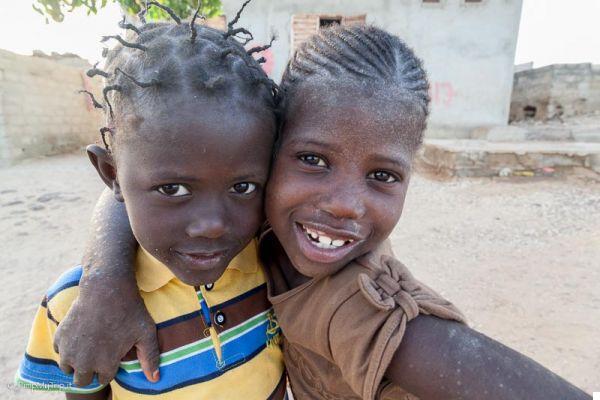
Since in the winter season (the driest and coolest) day temperatures are around 25 degrees or even more (I found 35 degrees), bring light clothing.
In the evening, however, it can be cool so a jacket or a nice sweater is better to put them in your suitcase.
Since it is very difficult to find hotels that provide laundry services, you will have to wash your own things: bring clothes that dry quickly also because given the wind and the dust you might find them already full of sand before you even wear them.
During my trip I noticed many tourists in rather skimpy dresses, with very short skirts or sarongs.
Senegal is a very tolerant Muslim country and the inhabitants are used to our clothing (especially in coastal and tourist areas). However, I believe that it is not respectful to go around half naked so you cover your legs or at least at least cover them up to the knee.
I also saw topless tourists on the beach. Here it is for me avoid. A nice costume is the best choice.
Senegal also has a big problem with garbage. I cut my foot on the beach with a glass, but it could have been a lot worse, thank God
I had my Teva sandals.
To go around the street, however, it is better to wear closed and light shoes, the risk of getting injured or cut is very high.
- Teva sandals
- Costumes
- light linen or cotton trousers
- a sweatshirt or sweater for the cool temperatures of the evening
- lightweight t-shirts that dry quickly.
- hat
- sunglasses (absolutely essential)
- Beach towel
Other essential things to bring
- Head torch: not all structures have light for 24 hours (especially in some remote and less touristy areas) and more often there is no electricity.
- Multiple socket: if you have several smartphones or cameras to charge, there are not many sockets in hotel rooms. Bring a multiple.
- Guide to Senegal
If you want, you can take clothes or school things with you, such as pens and notebooks, to give as gifts for the children of the villages.
Il common sense he tells us not to give them directly to the children but to some reference adult in the village who will then divide things up equally to everyone. No candy: they make your teeth rotten.
Don't forget that many things we take for granted here in Senegal are a luxury.
How much does it cost to travel to Senegal?
Travel to Senegal is, for those who decide to use public transport, quite cheap, but not as cheap as you might think. So don't think it's like India for example. To find more or less Western standards, prices go up a lot.
Hotel, guest house and camp
The hotels, guest houses and campaments that are suited to our standards are almost all run by Western people (mostly French who don't speak a word of English) and have higher prices than you might think.
In highly touristic areas (perfect for those who love holidays in tourist villages), such as Saly e Somone on the Petit Cote or the island of Goreè, the prices for a double room with breakfast included are from 25.000 francs sefa upwards (around 40 euros).
In less touristy areas, however, prices do not drop much. Breakfast is almost always included.
Restaurants
In Senegal, eating street food is not always recommended. Absolutely avoid raw food (such as oysters that you will often find) unless you want to risk some food poisoning.
The prices, however, even in restaurants are very low compared to our home and a plate is almost always sufficient, as the portions are always very abundant.
For example, for a fish dish (shrimp or sea bream and grilled fish) with a side dish (fries) and a beer (Gazelle and Flag are the two local beers) it is very difficult to spend more than 10 euros.
Public transport
I public transport they are definitely very, very cheap. On a bus or a collective taxi for a medium distance (for example 50 km) it will be very difficult to spend more than 5 euros each.
Sometimes bags are counted as people, so if you are two with backpacks, expect to pay double the rate.
What to see: the places not to be missed
Dakar Rally
La Capital of Senegal it is a city that can be defined in many ways but certainly not boring.
Dakar is characterized by very strong contrasts: here elegance meets cosmic chaos, the gray and dusty streets are colored by the markets and women's clothes, the clubs after sunset are filled with boys and sexy music, while the rooftops echo the call to prayer for devotees.
Dakar (like all of Senegal) is the city of paradox, where reality is capable of surpassing any imagination.
It is not a city to visit hoping to find great artistic things, but immerse yourself in its vibrant nightlife it will show you it from a completely different perspective.
Gorée Island
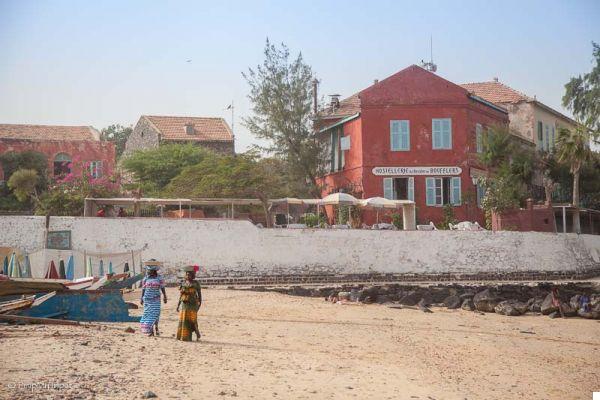
Absolutely unmissable for the story it tells, theisland of Gorée it is located just 20 minutes by ferry from the center of Dakar and has been a UNESCO World Heritage Site since 1978.
Read how to visit Gorée Island in 1 day from Dakar!
While Dakar is chaotic, busy and messed up, the island of Gorée, without cars or paved roads, is a corner of absolute peace.
But, even though it is an absolutely wonderful place today, the history of the island tells the nightmare of its past.
In fact, from the 15th to the 19th century, this small island was one of the largest slave trade points who were locked up here before being sold and shipped to America, the Brazil and the Caribbean.
Today the island is a living memorial of what happened and continues to be a symbol that reminds us of the crimes committed, because the important thing is to never forget what man was able to do.
One day is enough to visit the island. The ferry leaves approximately every half hour.
The places to visit are not many but they are really interesting: the highlight is certainly the house of the slaves, where men, women and children were imprisoned before being sold in chilling conditions, which is not to be missed.
But apart from being the slave island, Gorée also has a pretty beach, alleys with colonial houses carpeted with multicolored bougainvillea and other museums and places of interest.
Toubab Dialaw
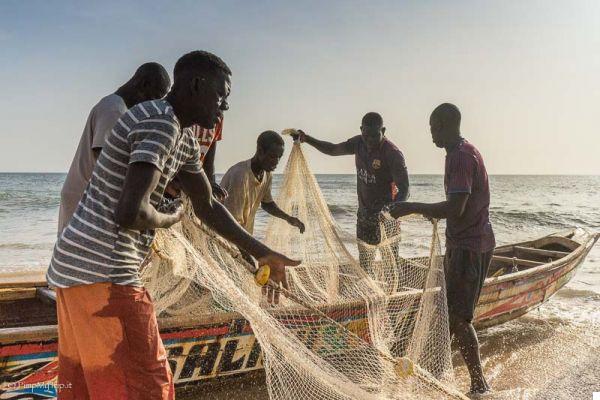
Magical moments at sunset when the fishermen return to the beach with their pirogues loaded with the catch of the day
When I visited Senegal I spent a few days in Toubab Dialaw, a small fishing village just outside Dakar, characterized by a quiet and relaxed atmosphere, completely different from that of the capital.
I stayed in a very nice and cheap B&B, the Begue Pokai, which is located a short distance from a beach of white sand and soft as cotton balls.
You can book il Begue Pokai easily here on Booking.com.
I think those spent in Toubab Dialaw were among the best moments of my entire trip.
In the evening I loved walking on the beach, watching the fishermen's pirogues
come back at sunset loaded with fish, play with the children and eat in one of the restaurants a stone's throw from the sea.
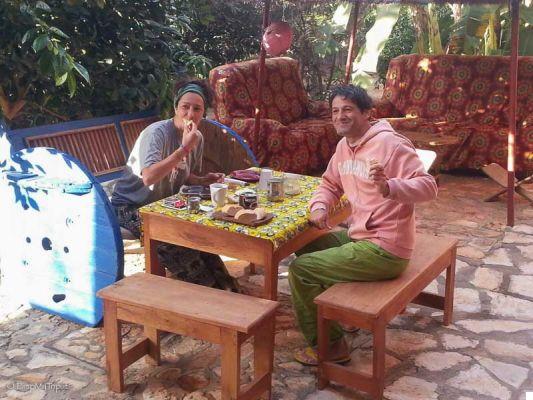
Breakfast at Toubab Dialaw's Begue Pokai (thanks to Giorgio for the photo!)
Toubab Dialaw is within walking distance (about 15 km) from the new Dakar airport and it is therefore an ideal base in which to stop for a couple of days and to visit Dakar and its surroundings.
The Begue Pokai is a great choice, comfortable, clean and affordable before resuming your journey.
Yoff and the Isle of N'Gor
Yoff is a village characterized by its strong Islamic culture: drinking and smoking are forbidden and travelers should dress appropriately by covering their legs and arms.
In addition to visiting the Mosque, it is worth taking a walk on its beach: apart from the rubbish and the crowds, the views over Dakar are truly beautiful.
In fact, Yoff is the most popular beach for Dakarians, being just a few kilometers away.
The beach is therefore always very crowded, but being very popular there are music, parties and lots of water activities such as surfing. Try to be there at sunset, the show is worth it.
With a passage in the dugout, theisland of N'Gor it is a great destination for a day of sea and relaxation near Dakar.
The sand and the beach are clean, the atmosphere relaxed but cheerful and you will find almost only families, street vendors (but not as nagging as on the island of Gorée) and young boys playing the djembe.
Saint Louis
La colonial city of Saint Louis it is the perfect mix between a fishing village and a city rich in history and culture.
In the city its brightly colored buildings, although some are now in ruins, carry the history of the past.
The streets are narrow and the old and historic part of the city can be easily visited on foot in just one afternoon.
South of Saint Louis, the strip of sand is dotted with beautiful beaches (despite the rubbish!).
While you may be tempted to spend the whole day swimming and sunbathing (beware of sunburn), a trip to the city is worthwhile.
In the old town you should not miss the Cathedral, Governor's Palace great mosque and the beautiful and famous Ponte Faidherbe.
Among the museums it is worth visiting if you like photography CRDS Museum, while if you are passionate about crafts you cannot miss the Tess workshops.
If you have a couple of days it is highly recommended to go down to Zebrabar and visit the Parque National Langue du Barberie (famous destination for birdwatchers for the many varieties of birds) in which, even if it is possible in the day, in my opinion it is worth spending a little more time.
Sine Saloum
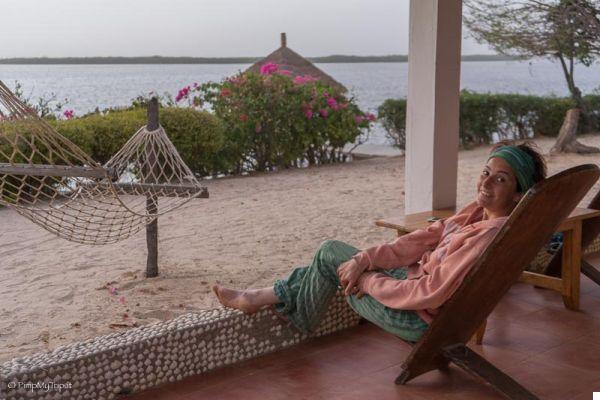
Relax a Mar Lodj nel Sine Saloum
I was in Senegal for a few days, but was sitting on the white sand of a small remote beach in the Senegal Delta, the Sine Saloum, which I "heard"
truly and for the first time, the essence of the other Africa, the West.
A UNESCO World Heritage Site, the Sine Saloum forms at the confluence of two rivers, creating an estuary and a region rich in biodiversity.
Nothing in Senegal has given me the same peace as spending a few days here, gliding with pirogues through the maze of mangroves, visiting small
fishing villages and spotting all kinds of birds: herons, kingfishers, pink flamingos and many more.
Casamance
My big regret (or my big excuse to return to Senegal sooner or later) is the Casamance region, in the far south of the country and separated from it by the Gambia strip.
Inaccessible until a few years ago due to the independence conflicts that ravaged the region, Casamance is an absolute must-do if you have enough time.
The best and fastest way to get there is by ferry that leaves from Dakar (but book it in advance, you cannot, at the moment in 2017, book it online unless you rely on an agency) or by renting your own car .
In the second case, consider that you will have to cross the Gambia and at the borders you can risk wasting a lot of time.
Joal-Fadiouth (island of shells)
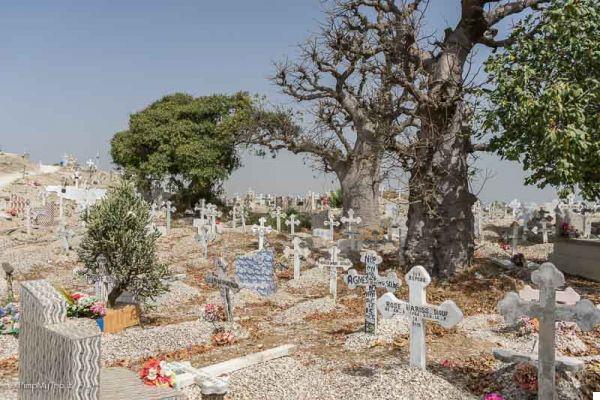
Fadiouth shell cemetery where Christians and Muslims have rested together for hundreds of years
About 30 minutes from Mbour, at the end of the Petit Cote, are the twin villages of Joal and Fadiouth, where Christians and Muslims live side by side, proud of their mutual tolerance.
While Joal is on the mainland, Fadiouth is an island made up entirely of shells.
Fadiouth is one of the most visited destinations in Senegal.
Its peculiarity is that it is totally artificial: for centuries the shell collectors have poured the shells here, creating a real island. Even the houses, the walls,
churches and mosques are all built in shells.
Fadiouth is also famous for another reason: its cemetery, also made up entirely of shells, where Christians and Muslims have rested peacefully side by side for hundreds of years.
If you happen to be here on Sunday morning, don't miss the "gospel" mass in the large circular church!
Pink Lake (Retba Lake)
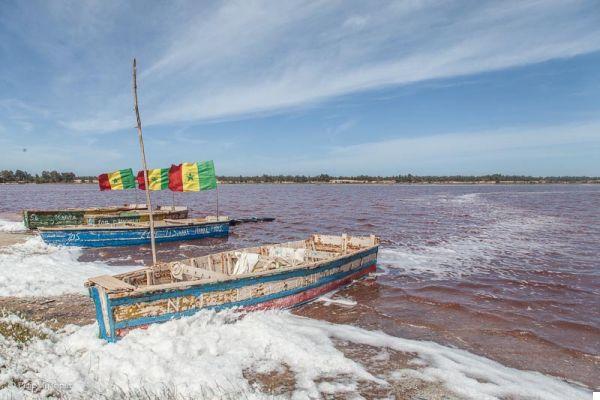
Salt flats of Lake Retba (Pink lake)
Less than an hour from Dakar (but don't underestimate the heavy traffic), there is an unusual lake (but very well known as the famous Paris-Dakar ended here) that surely catches the eye thanks to its vivid pink color: the Lake Retba (the Lake Rose).
Its particular color is caused by the Dunaliella Salina algae (a halophilic bacterium), which is attracted by the high salt content of the lake. The algae produce a red pigment to absorb sunlight, giving the lake its unique color.
The color, however, is completely harmless to humans and you can swim even if given the high concentration of salt (think greater than that of the Dead Sea) it is better to be able to rinse immediately.
For many people, however, the lake was a disappointment as it often has a rusty color rather than bright pink: to see it at its maximum splendor you will have to hope for a day with sun and no wind.
It is interesting to take a boat ride in the center of the lake to get to know the work of the salt collectors up close.
Lompoul Desert
The only place in Senegal where true desert lovers will find "dunes" for their teeth.
Il Lompoul desert it looks like a little piece of the Sahara that has broken off: camels nonchalantly carry tourists up and down the windswept dunes with the unhurried rhythms of past travelers.
Experiences not to be missed
Mbour fish market
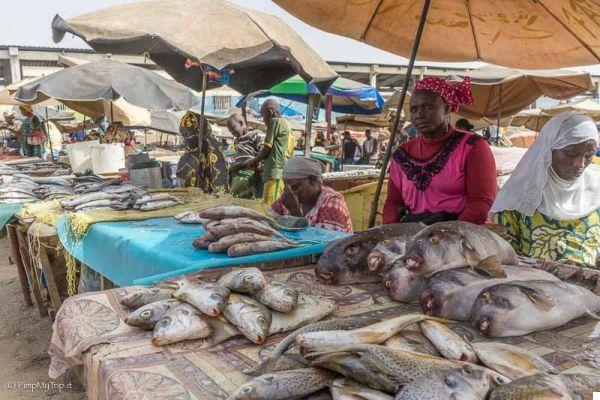
Fish stalls at the Mbour market
A destination not to be missed is definitely Mbour, famous for his fish market. Taking a tour of the market is a real experience.
Twice a day (but I recommend you to go there in the afternoon) dozens of colorful pirogues return loaded with fish that are cleaned, cut and sold directly on the beach: around the stench and noise are unimaginable.
Carts that come and go, transporters who run with sacks of fish on their backs (they are paid per kg), women who display all kinds of fish on their stalls: shark, flying fish, sole, puffer fish, sea snails.
It is all definable as a big mess but one of the truest and most unforgettable experiences to live here in Senegal.
Visit a small village
An opportunity not to be missed in Senegal is to visit, in addition to the most famous and tourist destinations such as the island of Gorée for example, also some small villages.
Life in the villages is completely different from that in big cities like Dakar, plagued by traffic and smog.
In the villages life is relaxed and community oriented, the people are open and friendly and will give you a warm welcome.
You will probably be greeted by swarms of children of all ages with the cry "toubab cadeau" or "ballòn ballòn ballòn", but ask the adults before buying the children anything.
Take a pirogue ride through the mangroves
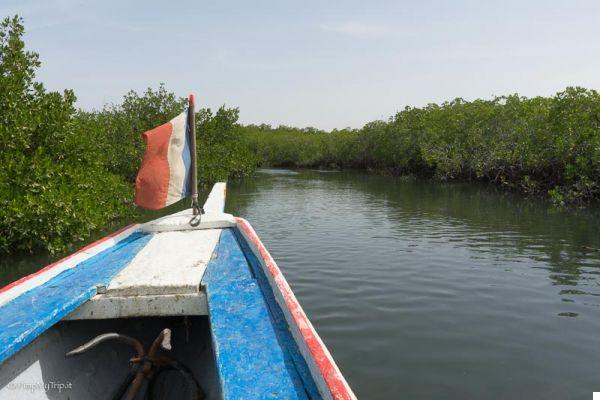
By pirogue among the mangroves of Sine Saloum
Another experience not to be missed is to glide gently with a pirogue in the lagoons, among the water channels, to spot many types of birds and oyster pickers that are born on the roots of mangroves.
Take a full day tour. In addition to the pirogue, the tour generally includes a visit to some fishing villages (which can only be reached by boat) and lunch (fish, but if you are vegetarian, say so and they will cook eggs) on the small pristine beaches of white sand .
The Sine Saloum is perfect for this, but also in Somone there is a beautiful lagoon (much more commercial and the visit lasts just over an hour) and also in Casamance.
Take a shared taxi
In Senegal, the first real moment you realize you are really in Africa is when you are about to take a sept-place.
The journey is very uncomfortable, but it is a real experience of Senegalese life: it is the means most used by the locals.
Crushed in the back seat among sacks of stuff, baskets full of smelly fish and boxes of chirping chicks, 11 crammed into an old and battered vehicle and used for 8 people, you will really have the opportunity to chat and get in touch with people.
Tiring experience let me tell you, but in return you will receive smiles and you will have the impression that you have traveled "really".
Things to absolutely taste
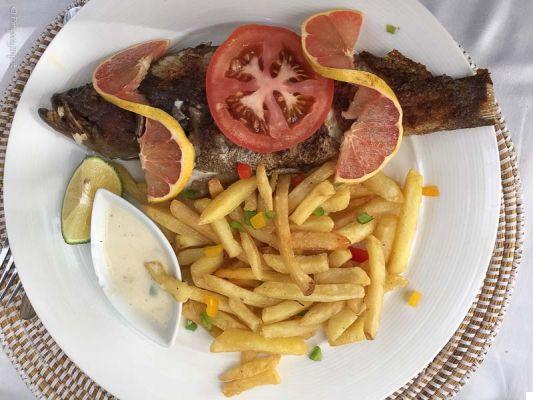
Fish is one of the main dishes in Senegal, with a side of chips and onion sauce
Senegal with its lakes and rivers makes fishing its main industry (3/4 of its inhabitants live on the coast).
Everywhere in the markets, women proudly display the catch of the day: sole, small sharks, puffer fish, shells, shrimps, crabs, in short, there is really everything.
Unless the fish is sold immediately, it is cleaned and dried in the sun to facilitate storage.
From a former colony, however, the traces of French culture left in the food are strong: the baguette is proudly carried under the arm, but the two most popular foods are rice (easy to prepare) and millet (ahhh the love for cous cous ...) .
The best known dish in Senegal is the Thieboudienne, a single dish of fish stuffed with rice and vegetables.
Thieboudienne
La Thieboudienne (or chebu jen in the local language, Wolof) is the typical Senegalese dish par excellence: in fact it is eaten by the family several times a week.
Originating (apparently) from the city of Saint-Louis, it consists of rice and fish, grilled or stir-fried and stuffed with a garlic paste (called rof).
This dish is accompanied by pieces of vegetables, cabbage, carrot or cassava, as well as dahkar (sweet and sour tamarind) and bissap, a sauce made from hibiscus leaves (not to be confused with the other bissap, that is the traditional drink that is instead obtained from flowers ).
Traditional toppings include gejj, or dried fish, and yéet, a dried shellfish.
Also, depending on whether there is sweet tomato in the rice, it is called ceebu jën rouge (red) or white. It is not difficult to love this dish, the flavors are fresh, bold and surprising.
Chicken Yassa
The chicken dish of Senegalese cuisine, lo Chicken Yassa, comes from the Casamance region in the south of the country.
The chicken is marinated in a thick onion sauce and served with a side of steamed white rice.
The soft onion sauce is reminiscent of French onion soup in flavor, while the stew is reminiscent of coq au vin. But the flavors, especially the tart lemon flavor, are unique.
Originally from Senegal, however, it is also found in other West African states.
Shrimp avocad
A more French than Senegalese dish and in fact very popular in the restaurants of the Petit Cote. Present in almost all menus, the shrimp and avocado salad is a healthy, light and tasty dish.
Shrimp, shrimp and squid dishes can be found everywhere in the hotels and restaurants of the Senegal coast: grilled, pan-fried with garlic or to enrich tasty salads.

Prawns with garlic
Try the Touba Coffee
The first thing my friend Antonella told me when she knew I was going to Senegal was: "you have to try the touba coffee!"
Born in Senegal as a medicinal drink, the touba coffee is a typical, spicy and intense coffee (you will find it in every corner of the country) made with a strong Arabica blend, whose coffee beans are ground with djar, an African black pepper (Guinea pepper) which is said to have aphrodisiac qualities .
Café Touba was allegedly invented by a revered mystic named Sheikh Amadou Bamba, who founded the Mouride Brotherhood, a branch of Sufism and the only Islamic brotherhood founded by a Senegalese. Bamba is said to mix coffee and spices for medicinal purposes and serve it to his followers.
Touba coffee is mostly served in tangana, street kiosks selling food and coffee, but be careful not to get confused with the ubiquitous nescafe vendors.
Touba coffee and nescafe are very different!
Bissap, bissap, bissap!
bissap (also called sobolo or zobo) is the most popular drink in Senegal along with touba coffee.
Bissap is a very simple drink obtained from different varieties of dried hibiscus flowers and which is, in effect, very similar to karkadè, only it is drunk cold. There is really nothing simpler than doing the bissap even in your home.
The hibiscus flowers are infused with boiling water: the resulting drink is then left to cool and is flavored in different ways with mint, pineapple juice, banana essence.
I assure you that there is nothing more refreshing than a glass of bissap during the day when the sun beats down hard and the heat takes your breath away. But don't drink too much, it raises the blood pressure a lot.
Try the Ditakh
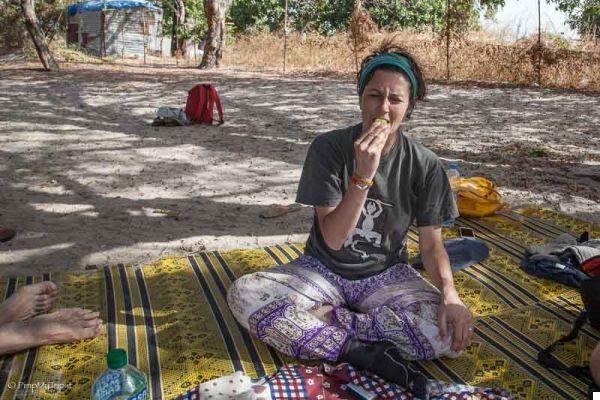
My first (and only) Ditakh
Il Ditakh it is a small spherical shape, with an external shell that looks like that of an egg and a phosphorescent green spongy pulp.
The taste is sour. In Senegal it is eaten or used to make juices and ice cream.
It has always been thought that it was a fruit with excellent properties. Lately it has instead been discovered that, apparently, it does not do so much good (but if you try it once it is absolutely not dangerous).
Having said that mine, after the first bite, ended up directly in the bushes behind me.
What if you are a vegetarian?
I mean, like me… Goodbye and good luck, get ready to give up a lot. In any case, in Senegal I found sensitivity in this sense: everywhere when I brought up the problem, I was offered an alternative. Scrambled eggs, cooked or raw vegetables but also pasta.
If you really don't know where to turn your head, order rice or fries, those are everywhere!
How to get around by public transport
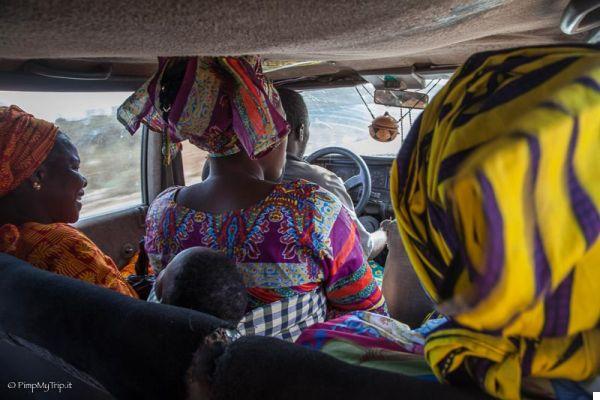
The “sept-place” collective taxis are the fastest (and cheapest) way to travel DIY in Senegal
Getting around in Senegal by public transport is a real pain: the major roads are well paved, but the minor ones are often full of potholes, the vehicles are old, super battered and without air conditioning.
But what is worse is that both buses and collective taxis (called sept-places) leave only when they are full which means that to get to the most remote parts of the country you could stay waiting in the garages (the stations where take the means) for hours before leaving.
The most popular and also the fastest way to travel in Senegal is undoubtedly with sept-place taxis. these are old ramshackle cars (mostly peugeot 504) with three rows of seats that can accommodate 7 people in addition to the driver.
In reality then don't be surprised if instead of 8 people in total you will be 11 or 12 because as long as there is space there is the hope of getting a ride.
In the sept-places, those who arrive first stay better and take the most comfortable seats in front. Those who arrive later will instead have to squeeze into the rear ones that have less space.
Collective taxis (and buses) can be taken either along the road calling them with the hand and asking the driver if he goes where you need to go, or in the garages, of the mega parking spaces that are used as stations.
For buses more or less it works the same except that they are bigger but it is much more difficult to understand what their final destination is. And they are slower.
If you want to travel more comfortably and faster, you can take a private taxi that will take you wherever you want to go.
In case, remember to always negotiate the price first. A trick: if you can't get a fair price, thank you kindly and walk away. In 90% of cases the taxi driver will call you back. If he doesn't, don't despair:
in Senegal there are many taxis, you will not struggle to find another one!
The only caution is to try to ask for a fair price, do not exaggerate in not wanting to spend or save on a euro, especially in a country like Senegal.
Sex tourism
I never wanted to write about this, but since Senegal is one of those destinations where sex tourism is widespread, I can't help but mention it.
On the beaches we often see Western men and women "of a certain age" clinging to local young people much younger than themselves.
The growth of sex tourism in Senegal has its roots in poverty and the lack of both jobs and opportunities for the country's youngest people (Senegal's unemployment rate is over 40%).
In Senegal, "prostitution", understood as a relationship between consenting adults, it is legal, even if in some ways it is splitting public opinion: on the one hand the elderly who think that easy and fat earnings are not a justification for going against their own culture, on the other hand the young of the new generation who think that "filling a single person with attention and pampering does not harm anyone".
For the young people of the place, therefore, sex tourism represents an unmissable opportunity: some guys ask for a night of love even 100 euros and for a whole week they take home even 2000 euros.
If you are white (especially if you are a white woman), you will have to get used to being the center of attention: especially if you walk on the beach alone, there will be some young people who, approaching you, will want to talk to you with a "Hello, beautiful!" .
However, at least in my experience, it was enough to answer by making it clear that you are not interested in certain things with a big smile. I have never felt harassed in any way and the approaches have always been very soft.
If you are a woman in Senegal, always smile and everything will be fine. It is very important to arrive in Senegal being prepared for this thing: to smile a lot and not to take these approaches too seriously.





